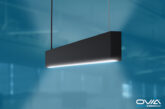
Michael Mulhall, Technical Manager at NVC UK, explores whether the phrase: “this light fitting has a UGR of less than 19” is essentially a myth.
No light fitting can have a UGR of less than or equal to 19. This is like saying: “because I have a voltage tester, I’m now an electrician”. There are, of course, a number of other steps you have to take before proclaiming the prestigious title, and buying the right tools is just one of them.
The same essentially applies to a UGR value; a number of factors affect the UGR rating, not just the light fitting.
So what is UGR?
UGR stands for Unified Glare Ratio. Glare, as defined in BS EN 12464-1, is ‘the sensation produced by bright areas within the visual field’. We’ve all been driving down the road and had to squint because the car on the opposite side had its headlights on full beam. The light that caused the effect on your eye is glare. There are different categories of glare:
1. Blinding glare
This does exactly what it says, it temporarily blinds you.
2. Disability glare
This directly affects visual performance. Similar to the car scenario mentioned previously, you squint, so your visual performance is decreased but you still have sight.
3. Discomfort glare
This is the one most applicable to us. Studies show this affects how you feel and perform in an environment but does not directly affect your visual performance. Now we understand the levels of glare, UGR is the numerical way that we measure it.
Where is this term used?
The term UGR is used, and is applicable, in all working environments. The term ‘a UGR of less than or equal to 19’ commonly refers to office environments.
Why is this important to you?
‘Blinding’ glare and ‘Disability’ glare are a big bold ‘no’ for office environments; instead it’s ‘Discomfort’ glare that we’re trying to measure and control. Studies show that it affects people in a variety of ways, such as headaches, eyestrains, increased absenteeism and accidents.
It’s such a hot topic, in fact, that the British Standards Institution (BSI) has produced a complete set of standards largely populated with UGR tables, amongst other important information: BS EN 12464-1:2011 – Light and lighting – Lighting of work places.
Whether you’re an installer, an employer, a building owner, a lighting designer or a consultant, you must take note of glare as there is a responsibility to ensure workers have a safe and healthy environment to work in.
Didn’t read the Standard? Don’t worry because we did! As a result NVC Lighting can produce a complimentary lighting scheme that shows that your environment has a UGR of less than or equal to 19 (if that’s what’s required, of course) using top quality NVC branded products. Our expert design team will be happy to help.
How do lighting manufacturers achieve UGR values?
The first answer relates to the light fitting itself; the control of the light or ‘optics’. The materials we use for diffusing the light are specialist materials that not only help to distribute the light into the areas that we want it to be distributed, but also control the glare. The positioning of the light source (LEDs) is also crucial. The two go hand-in hand in creating the perfect product for UGR compliance.
Why then does the light fitting not have a UGR of less than 19?
This is the million dollar question and the second part of the answer to how we achieve UGR values – it’s about the lighting scheme, not just the light fitting!
There are a variety of factors relating to the working environment that are included in a UGR calculation: the dimensions of the room, the colour of the walls, the colour of the ceiling, the colour of the floor, the height of the viewer and where the viewer is in the room. Without all of this information a true UGR value simply cannot be given.








